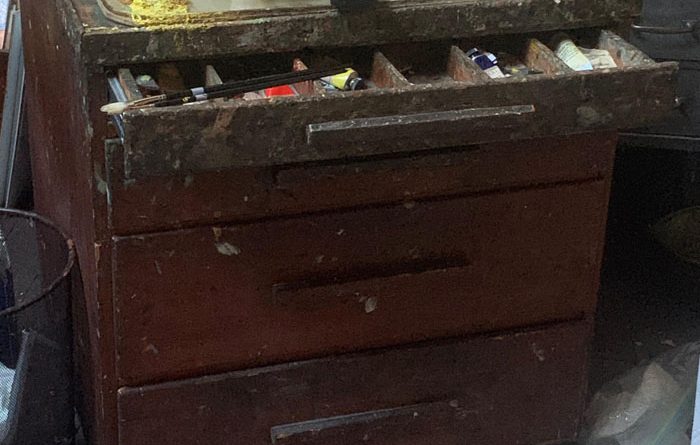Art Studio Tips by Sherrie McGraw
Jackie and Sherrie discuss how Sherrie Built Her Art Studio. Read about Sherrie McGraw’s Art Studio Tips below and their conversation.
Jackie: Hi Sherrie.
Sherrie: Hi Jackie, I love these conversations we have for the blogs.
Jackie: Well today is very special for I think all of our students because it’s questions that they’ve had about building an art studio. And I know that you have really built your studio from scratch. What was the most important thing that you had in your mind when you began your project?
Sherrie: Well, the most important thing was actually getting the light to be true North. And then we actually made it a little bit East of North because of where we are. We were getting sun in, in the afternoons, in the summertime when you can paint late. We really wanted it to not have sun in the afternoon. That was our, actually, our main reason for building a new studio. And besides that, it was also to make it a little bit bigger, you know, because we had had studios that were 16 by 20, 16 wide, 20 long and they were pretty good. But to have a model, we just were thinking it would be so much nicer to have a bigger art studio.
Jackie: And what is the size, dimension of your art studio currently?
Sherrie: It’s 24 feet wide by 30 long. I’ll kind of give you a little bit of a pan here. Now I’m looking. Where am I looking toward? Oh, okay. Is that, Oh that’s behind me. Okay. Okay. Well, so now you’re kind of seeing the skylights up there and, the long way is 30 and then 24 is the width.
Jackie: Do you want to talk a little bit about how you control the skylights? Because I see that there is some covering over them.
Sherrie: Yes. That’s very astute. I can just kind of show you that what we have is we have, you can kind of see that they are shades, so they are shades, we have two shades on each window. They go from the bottom up, one set goes from the bottom up and the other set goes from the top down. And that way we can actually control, um, how much light comes into the studio. I could actually close this up more, and show you now that I’ve taken out a little bit of light on one side by raising the shade. And that’s actually also very important because it allows us to control the amount of light that comes into the studio.
Jackie: Do you want to talk a little bit about the furniture, the furnishings in the studio?
Sherrie: Sure. The most important furniture obviously is the easel… just showing you my easel. This is the Mabef easel and it can go up really, really high so it can accommodate a really big, big painting or small paintings. That’s the most important piece of furniture. And then, because, I also love to do drawing, what I do is I have my drawings on this movable wall. Let me see if I can get you to see that. So what it is, is it has rollers on the bottom. It is a very lightweight wall and then it has homasote on it. I can pin the drawings to the wall. Then it has a handle on the side and so you can move it. You can see this handle on the side. Does that make sense Jackie?
Jackie: Yes it does.
Sherrie: Okay, great. Right. This a movable wall. I consider that really, really important. The other thing too would be, some sort of model stand, a chair in order to put a model on if you’re going to have models, this is another movable wall and you can see kind of more the way it is. Does that show Jackie?
Jackie: Yes it does.
Sherrie: Okay, great. Great, great. I would say that those are the most important pieces of furniture, stools to put things on. For example, my stools, I have a Taboret to also put my pallet on. This is an old one that I got from New York City. And then of course I do have a lot of flat files, which you can see one there. You can see one back in here. And I actually have more flat files here because I have so many drawings, so more flat files there. That’s why I would say most essential thing as well as having, if you paint still life, having something where you can set a still life up on. And you can see that I have a table that I have a still life set up on top and then I can set one up on the bottom and then I have another area where I can set up another still life over here so that way, and I actually back here have another table where I can do the same thing and something on top of that too. Anyway, I have a lot of possibilities of where to do a still life. And those are important too.
Jackie: What about artificial light? Do you paint at all by artificial light or do you use it to enhance the natural light?
Sherrie: Well, okay. Since we are lucky that we do have this wonderful North light I prefer North light and natural North light, so I don’t work with artificial light, but, they certainly make a lot of wonderful, bulbs today that are balanced to the daylight. And so people that don’t have really good light, you can do that. Now the other thing too that we did with our North wall, you know, and if you really, really, really wanted to have the best studio in the world, we angled the wall. Let’s see if she can see that. I don’t think you can. Anyway, but we angled the wall. It’s not perpendicular. We angled it, by 10 degrees so that, the light is coming more from on top. You know, and again, this is really, we made the ideal studio, so that is in our estimation. That is David and me. Yeah.
Jackie: In closing, can you describe the color of the wall and why you chose that color?
Sherrie: Yes. Yes. As you can see it back behind me. It is. I’m a grayish green. It’s very neutral, and as you can probably tell, everything looks great against it. You know, all the objects really, really come out against it. And that’s why we painted it this color. It’s just a very neutral gray-green and probably a seven value. I’m going to guess six. I’m not very good at that, but six or seven value probably.
Jackie: Thank you so much Sherrie McGraw.
Sherrie: You are so welcome. I hope this helps anybody that is trying to set up a studio.
Jackie: Oh I know it will.
Sherrie: All right. Thank you for watching.
To learn more about how you can become a member and access 100-300+ world-class painting and drawing classes, visit The Artists Guild.




Leave a Reply
You must be logged in to post a comment.